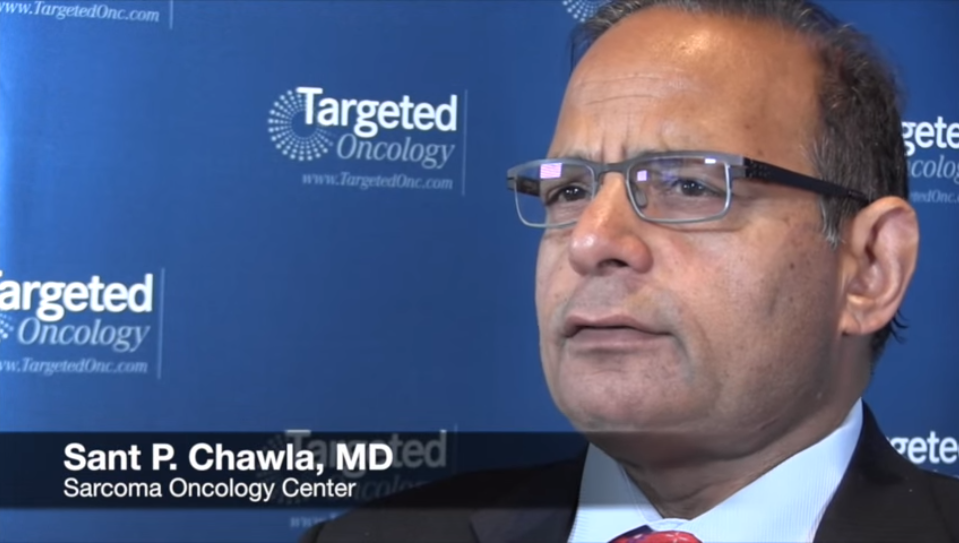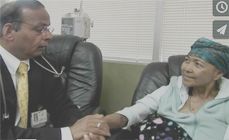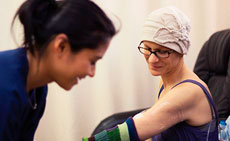Soft Tissue Sarcoma Explained
Soft tissue sarcoma is a rare form of malignant tumor that can develop in the connective tissue almost anywhere in the body along a tendon, ligament or muscle. This type of sarcoma occurs in approximately 1% of adult cancers and 15% of children and teen cancer cases.
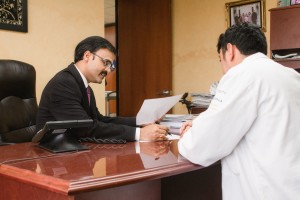 There are approximately 75 different subtypes of soft tissue sarcomas which means the disease varies widely in risk and prognosis. For that reason, treatment can span from less invasive chemical therapy to extensive medical care involving a combination of chemotherapy, radiation, and surgery.
There are approximately 75 different subtypes of soft tissue sarcomas which means the disease varies widely in risk and prognosis. For that reason, treatment can span from less invasive chemical therapy to extensive medical care involving a combination of chemotherapy, radiation, and surgery.
Dr. Sant Chawla and the oncologists at the Sarcoma Oncology Center in Santa Monica are intimately involved in each patient’s care. We collaborate with surgeons, radiation oncologists, radiologists, and pathologists from other prominent institutions to ensure that the complexity of each case is addressed in its entirety. Our patients receive personal and individualized attention from the most prestigious oncologists worldwide who are specialists in sarcoma and its numerous forms.
Since the spectrum of soft tissue sarcomas subtypes is extensive, sarcomas are classified into specific categories by tissue of origin. Grouping subtypes helps in disease management by identifying a cancer’s genetic alterations, clinical behavior, therapy sensitivity, age of occurrence, aggressiveness and growth pattern. The most common subtypes are grouped as:

Leiomyosarcoma
Smooth muscle sarcomas are highly variable and can arise anywhere in the body. Approximately 60% of this type occurs in women with an average age of 60. The primary site for women with this sarcoma is in the uterus; however, it can originate in the small intestine, stomach, blood vessel wall, the abdomen, arm, leg or skin.
Synovial Sarcoma
Sarcomas which arise adjacent to joints. These tumors typically affect young adults and have a high risk of lung metastasis.
Vascular
Sarcoma of blood vessels comprises an uncommon group of sarcomas that appear to arise from the lining of blood vessels.
Rabdomyosarcoma
Sarcoma of skeletal muscle that typically affects children and young adults and has a high risk of lung metastasis.
Gastrointestinal Stromal Tumor
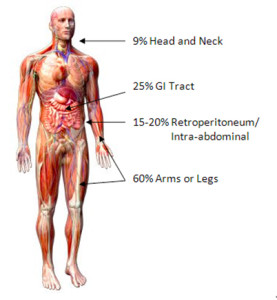 Sarcoma of the gastrointestinal tract.
Sarcoma of the gastrointestinal tract.
Peripheral Nerve Sheath Sarcoma
Sarcoma of the connective tissue surrounding nerves with high risk of lung metastasis
Rare Sarcomas (epitheliod, alvular soft tissue sarcoma, chondrosarcoma of the soft tissues)
Desmoid Sarcoma
Sarcomas arising from connective tissues which occur locally but can be very aggressive.
Uncertain Differentiation
This is a common type of soft tissue sarcoma that appears in late adult life. It typically manifests in the extremities and abdominal cavity. It was given this name because the diseased tissue does not resemble healthy cells.
Approximately 60% of sarcomas develop in the arms or legs with the remaining types originating in the gastrointestinal tract (25%), back of the abdominal cavity and its internal organs (15%-20%), or the head and neck area (9%).
Diagnosis of Soft Tissue Sarcoma
The Sarcoma Oncology Center in Santa Monica believes in treating the patient holistically so our first step with a new patient is a physical exam and collection of medical history. This approach enables the physician to access general health, gather information about signs of sarcoma, and conduct routine tests as needed. The Sarcoma Oncology Center in Santa Monica will help the patient coordinate receiving tests and scans as appropriate, including CT scan, PET scan, bone scan, MRI scan and ultrasonograph and/or endoscopy / laparascopy.
If an examination confirms that a tumor is present, a biopsy will be conducted. First, a sample of the tissue from the tumor is removed and examined microscopically by a pathologist. While imaging studies may clearly indicate the presence of a tumor, a biopsy will be performed to confirm whether the tumor is cancerous. From the tumor sample, doctors can determine the sarcoma type and grade, which is a predictor of the risk of metastasis.
For more information, visit WebMD.com.
Stages of Soft Tissue Sarcoma
There are multiple stages of a tumor’s development and the stage will determine how far the tumor has spread and what is the required treatment and recovery prognosis. The Sarcoma Oncology Center in Santa Monica applies a practice called “stage grouping.” This process assesses four tumor elements and invasiveness:
1.1) Primary Tumor – Tumor size and location
1.2) Regional Lymph Nodes – Tumor’s proximity or effect on regional lymph nodes
1.3) Distant Metastasis – Tumor’s evidence of metastasis
1.4) Histopathologic Grade – Tumor grade
The oncologists at the Sarcoma Oncology Center in Santa Monica will assign a stage, depending on pathology and radiology findings as well as the grade of cancer.
Treatment and Medical Care of Sarcomas
The oncologists at the Sarcoma Oncology Center in Santa Monica have the expertise to go beyond standard cancer care and soft tissue sarcoma treatment since we have access to the most novel cancer drugs at our fingertips. We are leaders in sarcoma research and pioneers of the cutting edge sarcoma clinical research trials in the world.
The Sarcoma Oncology Center in Santa Monica implements treatment plans that are team-oriented, multi-modal and unique for each patient. Sarcomas are a complex form of cancer requiring a specialized team of physicians collaborating together to help a patient for treatment of soft tissue sarcomas. The Sarcoma Oncology Center in Santa Monica is joined by prominent surgeons, pathologists and radiation oncologists from institutions such as UCLA, USC, Stanford, M.D. Anderson, St. John’s and Cedars Sinai who work with us to develop and implement the best multi-modality treatment plan for each case. We work together to develop the best course of treatment which includes consideration of the grade and stage of a tumor, prior treatments (if any), progress of the cancer, biopsy analysis and other individualized factors.
 Clinical Trials at Sarcoma Oncology Center
Clinical Trials at Sarcoma Oncology Center
At the Sarcoma Oncology Center in Santa Monica, our expert oncologists are actively involved in clinical trials of the newest drugs and work with a team of experts to develop the best treatment plan for each individual.
Dr. Chawla is the international principal investigator of Yondelis (Trabectedin) which is the most effective treatment for liposarcoma. This medicine has been approved in many countries and pending approval in the United States.
He was the principal investigator of Imatinib (Gleevac) which is the treatment for GIST (Gastrointestinal Stromal Tumor) and approved in 2012.
Chemotherapy
Chemotherapy is the most important treatment available for sarcomas because it is the only form of treatment which prevents and controls the spread of the cancer into the lungs, vital organs and other parts of the body. The chemotherapy of the past was highly toxic and had significant side effects. Thanks to new treatments pioneered by Dr. Chawla in collaboration with internationally renowned oncologists, the side effects of chemotherapy have been significantly reduced and are virtually nonexistent in many cases. New treatments protect the heart and kidney, substantially reduce infections and the need for blood transfusions and virtually eliminate nausea and vomiting for most patients.
Chemotherapy is an art and science and the right combinations of treatments aggressively eliminates cancer, prevents recurrence and maintains the patient’s quality of life through treatment. Over 50% of Dr. Chawla’s patients can work during chemotherapy and maintain their daily routine activities and exercise through their treatment.
Surgery and Radiation
Surgery can be a particularly effective option after initial chemotherapy to shrink sarcoma tumors. With the advent of new adjuvant chemotherapy, improved technique in surgery and the availability of internal prostheses, amputation is now avoided in approximately 95% of sarcoma cases.
Radiation is another effective tool used to combat sarcomas in specific, localized areas. Radiation works by sterilizing the tumor cells and making them unable to divide and continue to grow.
Contact the Experts for More Information
Sarcoma Oncology Center in Santa Monica offers patients the best possible solution and considers the physical and emotional well-being of each individual. Please contact our center in Santa Monica at 310-552-9999 to schedule a consultation with one of our specialists.
Next, learn about Bone Sarcomas.

